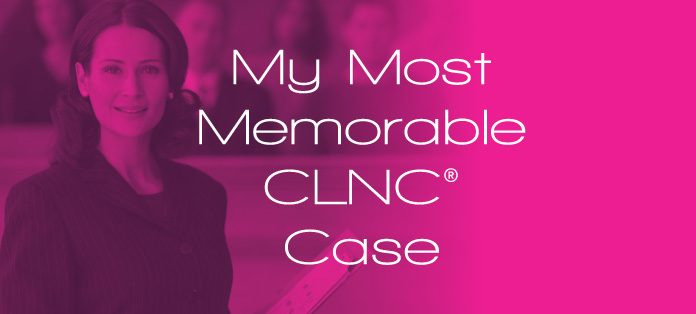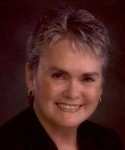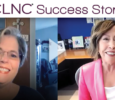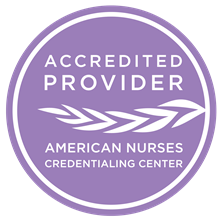I doubt any of us, as CLNC® consultants, ever forget our first case. Mine is most memorable for several different reasons. I learned so much, some of it the hard way. I had earned my CLNC® Certification a few months earlier and used the Institute’s advice regarding marketing myself by mailing out my resume with my qualifications and a cover letter, then followed up with a phone call. One attorney had a case on his desk, which had been referred to him by another attorney. The case involved a potential client who lived out of state. The attorney drove approximately six hours one way to interview the potential client and his wife. He felt there was probable merit to the case but he needed someone to review the records. He had filed the proper notices to all the possible defendants of a medical malpractice lawsuit.
I was so excited the day the records arrived at my home. There was a large amount of records as the potential plaintiff had a five-week hospital stay with numerous complications. So I began the screening process.
The potential plaintiff, Mr. Smith, had recently been diagnosed with Hodgkin’s disease and had a mediport placed for chemotherapy treatments. However, the symptoms of a pre-existing esophageal diverticulum had become so pronounced that he decided to have an elective excision of the diverticulum with a myotomy before starting chemo treatments. Mr. Smith had an extensive medical history including a previous heart attack with placement of a stent, hypertension, hyperlipidemia, three back surgeries and diabetes.
Mr. Smith experienced several complications after the first surgery, one of which made it necessary for placement of a chest tube, which was done at the bedside by the surgeon. Mrs. Smith alleged she had not been called at home for permission so proper consent was not given for the procedure and it caused Mr. Smith excruciating pain, which resulted in a second heart attack and a transfer to ICU.
The dots just weren’t connecting. Something wasn’t right. Mr. Smith had a second heart attack which was confirmed by the medical records, but how could I prove what happened to him? How could pain from the chest tube insertion, etc., cause the second heart attack? He already had a stent resulting from the first MI, combined with the high cholesterol and diabetes.
So here I go, back to my Core Curriculum for Legal Nurse Consulting® textbook. It almost jumped out at me, as if a light bulb had suddenly come on in my head! In Module 3, “Theories of Liability and Defenses Used in Medical-Related Cases,” it discusses the four legal elements, which must be satisfied to prove negligence: duty, breach of duty, damages and causation. The definition for causation pretty much says it all: “A reasonable connection between the acts of negligence and the alleged damages.” I felt the other three elements of duty, breach of duty, and damages were satisfied, but not the element of causation. So I read further. Under, “Factors to consider when evaluating causation,” it lists as one of the factors, “Past medical history and pre-existing conditions.” I continued to read and found that Module 5, “How to Screen Medical-Related Cases Effectively and Efficiently,” discusses defensible cases which plaintiff attorneys frequently reject because of pre-existing conditions.
So here I am feeling pretty good about myself. I am ready to type my letter to the attorney advising him that in my opinion, his case does not have merit. I used one of the samples provided in the Core Curriculum to ensure my opinion sounded professional. I relayed to the attorney that I felt Mrs. Smith had some legitimate complaints regarding Mr. Smith’s hospital stay and that while it was sad he had experienced numerous complications, it was my opinion that the element of causation could not adequately be satisfied due to Mr. Smith’s past medical history and pre-existing conditions and then I went on to list all the pre-existing conditions.
The attorney very politely informed me that he wanted me to list the deviations from the standards of care and then he would make the decision whether the case had merit.
In a much later phone conversation, the attorney stated, “Ms. Holmes you were right in the first place.” Well, needless to say, this made me feel pretty good.
There are many things I learned from my first case. One of the most important things is to communicate thoroughly upfront with your attorney-client. Don’t assume anything. If in doubt, ask questions. I think there are many attorneys, especially attorneys in small firms who have not worked with a CLNC® consultant before and really do not know how much help we can be to them.
I have twenty-two years of nursing experience and am confident regarding my nursing skills and judgment, but I am still building confidence as a Certified Legal Nurse Consultant. Owning a legal nurse consulting business is entirely different from what I have been accustomed to doing for a paycheck. This case did boost my confidence. My first conclusion was correct and the attorney finally agreed. If we are not honest with our attorney-clients about our findings, we both will come out losers in the end.
I believe everything we need to be a successful CLNC® consultant is included in the Core Curriculum for Legal Nurse Consulting® textbook and the lectures that go along with it. The Institute’s CLNC® Mentoring Program is invaluable. Each time I have used the mentoring program, my questions were answered in a very timely manner, sometimes within a couple of hours. I live in a small town and I feel isolated at times. With the mentoring program, no matter what the question is, support is readily available.
We have to make the decision to take the plunge. For me, I thought about it for approximately four years. And you know what, it’s scary. But I believe with help from the Institute and persistence it’s possible to be a successful CLNC® consultant.
P.S. Please comment and share your most memorable CLNC® case.
Peggy Holmes RN, ONC, CLNC owns and operates Holmes Legal Nurse Consulting in Arkansas. She has 22 years of nursing experience and currently works part time in The Women’s Center at the local hospital. She consults on medical related cases and specializes in orthopedics, pediatric and med-surg cases.










Great story Peggy! My first case is also memorable for the same reason; it was my first time to do everything that we had been taught by Vickie and I probably made some of the same mistakes.
An attorney had a personal injury case in which she wanted the medical records reviewed for possible malpractice. I attended the client interview and was able to educate the attorney about issues that she was not aware of like life care planning, vocational evaluations and job placement issues. This particular case involved an MRSA infection contracted during outpatient therapy. The original work injury required knee surgery to repair torn tendons. In this case, as with yours, there was no causation. I almost felt like I was giving the wrong answer to the attorney. But she was impressed that I could explain that the causal link was just not satisfied. Like you, I relied on the Core and the CLNC® Mentors.
My mistake was not getting a referral letter from this attorney before she moved. I worked on five cases for her in about an eight month period. On a follow-up call that I made to her, she told me she was closing her office. Two weeks later, her office was empty and I had no contact information.
The blog the other day about what to include in a referral letter for an attorney was a reminder of the referral letter that I let get away. If an attorney is ranting and raving about how he or she is pleased with your work and knowledge, ask if you can have it in writing. If he or she is too busy, offer to write it for them.
P.S. Peggy, my most memorable time at the 2009 NACLNC® Conference in San Antonio was eating barbeque at a Riverwalk cafe with you and several other CLNC® consultants while you shared with us your most memorable case and “the rest of the story.” You were a maverick and stuck to your guns! We all laughed and had a good time when we walked back to the Marriot in the rain (my husband still talks about it). Thanks Vickie for making these memories possible for us!
As with Peggy and Diana, my first case also would not have been possible without the wonderful CLNC® Certification Program. I networked as Vickie recommended and made my first successful interview call while attending the NACLNC® Private Apprenticeship. Three months after becoming certified, I received my first case. I have years of OB/NICU experience, but my first case was a nursing home negligence case! I used several reference reports and submitted a CLNC® Mentor request (I knew nothing about nursing homes!).
With all this support, I was able to confidently present my screening, produce a 40-page chronology and review the original records at the defense firm. This case is now slated for trial this summer, and I know I will have no difficulty providing great work with the help from Vickie!
No other legal nurse consulting program supports us the way Vickie, her staff and CLNC® Mentors support us. If I had chosen a different path to consulting, I would not be successful today. I am a SUCESSFUL CLNC® consultant!!!
Peggy, great job!
My first case came from an attorney who found me from the NACLNC® Directory! I was so excited. It was for a defense attorney wanting me to be a testifying expert. I was nervous about that. Most of our communication was verbal. I reviewed the depositions of all parties. The Core was my saving grace.
The case was about a home health aide who had been in the home two days helping with transfers and personal care. It was to be determined if she was adequately trained to be a HHA and if she was responsible for fractured leg due to fall in the home during a transfer. After reading the records that were sent, it was clear that this person had been dropped by her brother multiple times and EMS had been called to pick her up. The time of the injury didn’t match with the c/o pain and swelling with the severity of the fracture. I found enough evidence in the records to doubt the causation issue. I felt bad that the injury had occurred. There was documentation that the caregiver/brother had been told at some point by a PT that a hoyer lift should be used in the home as this patient could not always pivot transfer – they declined. They were also supposed use a gait belt or transfer board – not done.
Long story short, the attorney thanked me for my work as the settled instead of going to trial.
It’s fun being a detective!
Hi Peggy!
My first case happened in a funny way, which just proves that you have to be ready for an opportunity when it occurs or it will pass you by.
I was working for a case management company when I received this email that was sent to the group. “Does anyone know what a toxic tort is?” Oh my! I quickly replied to the email.
They quickly responded, “You have the job…call this attorney; he needs someone to review several files.” And so it was, several files and years later, I learned to research, take phone calls in the middle of the night for docketed cases that were going to mediation the next day, I learned what the attorneys needed to pursue their cases and exactly how to formulate a summary to make the greatest impact. Chronologies became a way of life with lists of the key players, the facts pointing to the issues. The attorneys on the cases were just so impressed with everything the nurses provided! It was fun, exciting and the opportunity came from out of the blue!
Nurses devote so much of their lives to integrity and hard work; I think it is the “nature of the beast” in each of us to provide a job well done. Training is everything though. An attorney (Vickie) taught me and I felt that she provided the foundation I needed to answer that email.
I have never looked back and each case I have taken from that point on just improved my skill. A self assuredness from the nurse in her knowledge is what wins the attorney’s trust. But when you can back up that knowledge with documented meritorious information, you then become irreplaceable.
Peggy,
Excellent article. I like your correlations and truths about our Core Curriculum textbook. I specifically like your comment about being truthful with attorneys. I met with an attorney this past fall and he talked about “wanting an objective point of view” with his case. Offering our objective point of view to attorneys is one of our keys to success, just like Vickie talks about in the Core Curriculum.